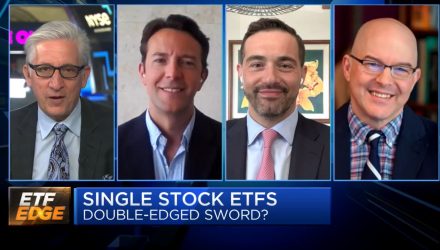The ETF industry has grown tremendously by packing plain indexes like the S&P 500 to investors, along with narrower slices of the market. Currently, the market is seeking to expand by offering narrower bets on individual stocks. On this week’s ETF Edge, CNBC host, Bob Pisani, speaks with Dave Mazza, head of product at Direxion, and Will Rhind, CEO of GraniteShares. Plus, ETF Trends’ financial futurist, Dave Nadig, is along to offer his thoughts as well.
Speaking to the notion of leveraged and inverse ETFs posing risks to ETF investors and creating potentially system-wide risk by operating in unanticipated ways when markets experience volatility or stress conditions, according to SEC Chairman Gary Gensler, Nadig notes how this may be a reasonable guess.
“We’ve definitely seen a significant interest by regulators on any products that don’t necessarily make a lot of sense when you look right up front, as you really have to dig in,” Nadig notes.
Those products may fit that bill, and while Nadig is not against single stock ETFs when it comes to letting people trade with leveraged volatility, these are products that belong in the mix. With that said, there could be a risk of some sort of contagion on the ticker front.
“Imagine there being 6, 7, 8 ETFs, all pegged against, say, Amazon. Now, do that for all the securities in the S&P 500, and you’ve literally got thousands of Amazon, and so on, adjacent tickers.” Nadig explains. It’s not a matter of their being at risk, but that people may get confused.
Traders Just Don’t Understand
Chiming in, Mazza notes how the biggest risk comes from people not understanding what they are getting into with these products. “You do have to recognize that they are not intended to be buy-and-hold investments,” He notes. Additionally, while the volatility may cause various changes in the overall outcome, on a daily bases, traders need to know how to use these products to gain any helpful information about what they’ve gotten into.
Additionally, “The idea that they cause systematic risk — in the actual market itself, I think it’s a bit of a stretch,” Mazza makes clear. Through many stressful environments for many years, the ETF structure has proven to be resilient, and, again, the encouragement of traders to understand how things work is what’s important.
For Rhind, by using leveraged funds, the one major risk has amplified returns, and therefore the potential losses could also be amplified. “When you talk about a product needing to close, the reason for that is because the move in the underlying market has been so big that with the leverage on top of it, the fund loses its exposure or the investor loses their money. But that’s important because, with these products, you can’t lose more than your initial investment, and that’s unlike many forms of leverage where the big risk is that you can lose more than your initial investment.”
With that being said, “The good news, in my mind, is that this is a safer way to do leverage than a lot of traditional investors are already doing in the market.”
For more market trends, visit ETF Trends.
